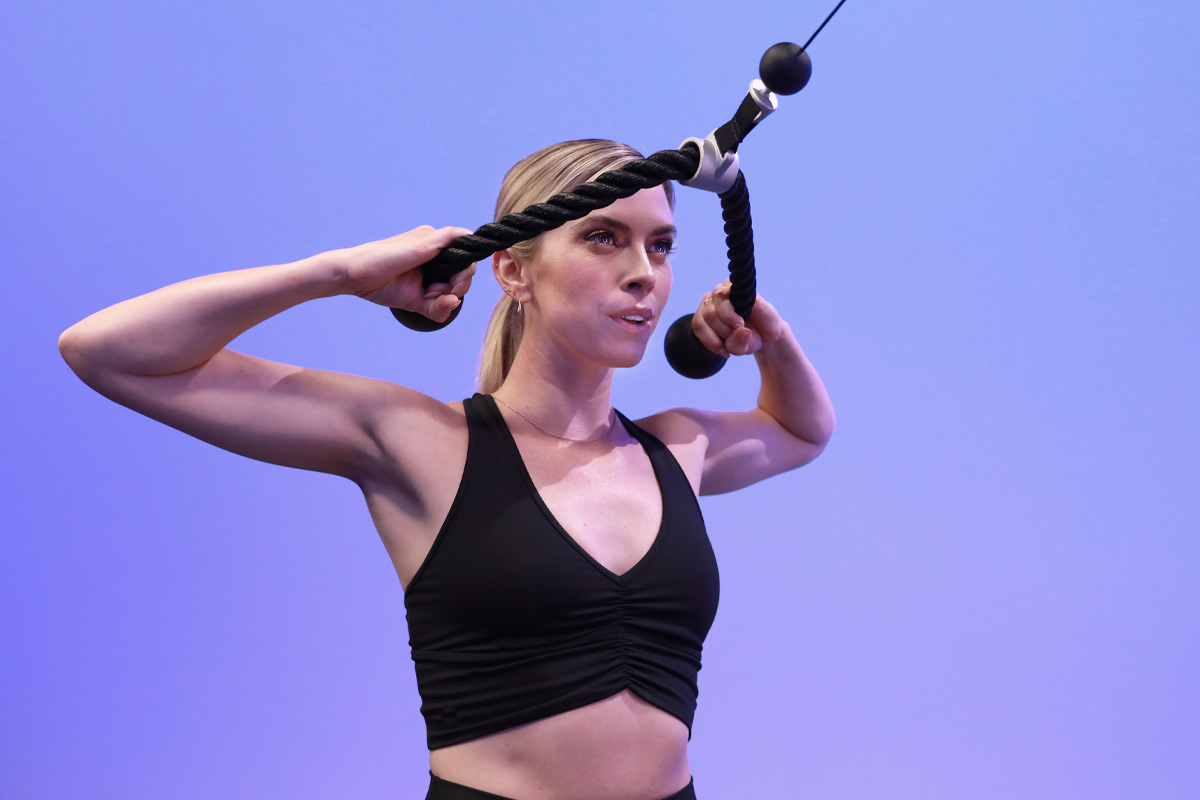As Coach Ash Wilking prepares for a 450-mile ride, she and other experts share tips for training off the bike.
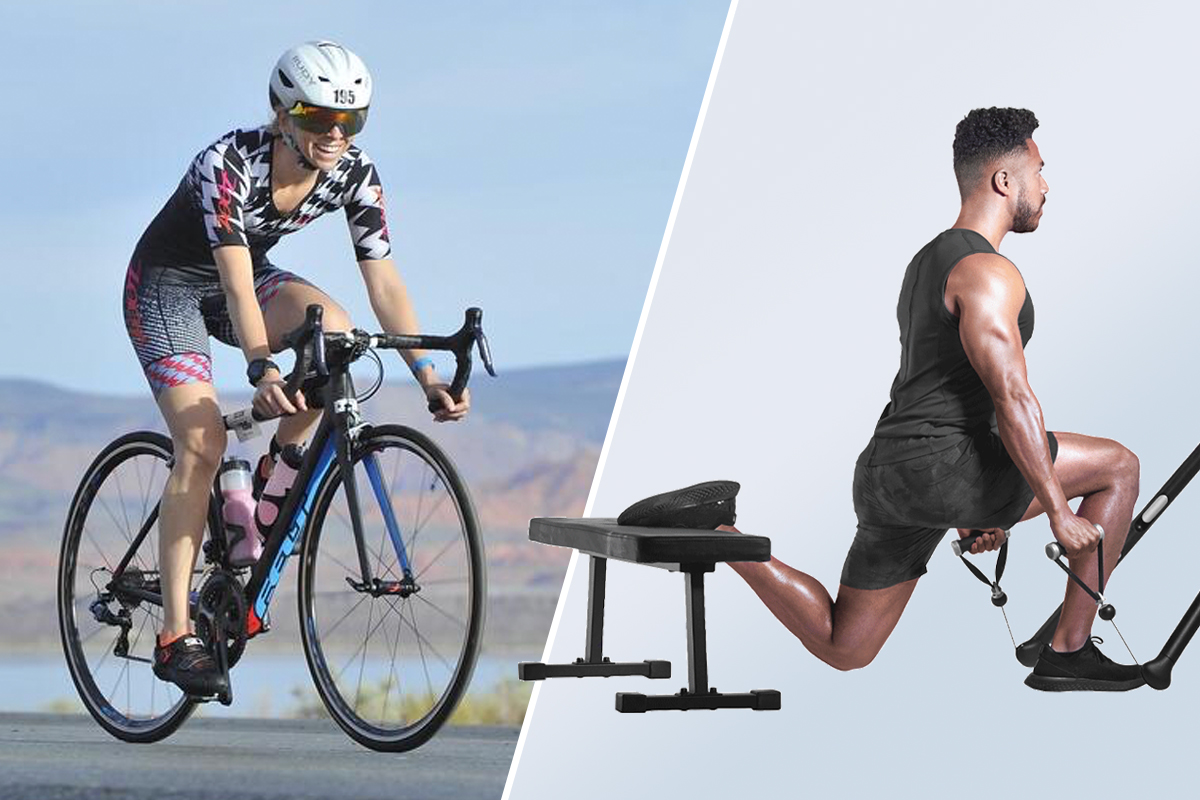
With all the talk of resistance, watts, and output, you could be forgiven for thinking your daily indoor (or outdoor) ride is a strength-building workout all on its own. But getting out of the saddle and adding in specific strength training for cyclists preps your body to handle additional load — a perk that will translate on the bike.
Tonal coach and certified personal trainer Ash Wilking, an experienced cyclist and triathlete, knows the value of including strength training in her routine. She’s currently training for a 450-mile ride from New York City to Niagara Falls to raise money for the Susan G. Komen Breast Cancer Foundation, in support of her mother who’s currently battling the disease. Along with putting in the hours on her bike, Wilking is also lifting heavy on Tonal to prepare for the days-long journey.
She explains that the repetitive motion of cycling creates a constant stress on the body that over time can cause injuries. Strength training for cyclists helps build resiliency against that stress.
“Strength training also helps build strong ligaments and tendons, which are going to support our joints,” she says. “The stronger those ligaments, tendons, and muscles are, the better and safer it is for our bone structure to be doing this kind of repetitive challenge.”

In addition to making you more resilient against overuse injuries, strength training can also improve your cycling performance. As Frank Baptiste, a certified strength and conditioning coach and cyclist, explains, “The stronger you are, the more force you can exert on the pedals, which propels you forward.”
But it’s not just about building stronger muscles to power your ride and bulletproof your body; it’s also about working a different energy system. Cycling is mostly an aerobic activity, meaning your body is using oxygen to meet energy demand. Strength training, on the other hand, is typically anaerobic, which means it doesn’t require oxygen to produce energy.
Here’s the catch: Your body is never using just one system, explains Baptiste, and sometimes you have to transition quickly from one to the other — kind of like cruising on a flat road then breaking into a sprint. “I like to think of it like shifting through gears,” he says. “You want to be strong and efficient through all of your gears.”
Another major benefit of strength training for cyclists is targeting imbalances or weaknesses. Say your knee is angled away from your midline or your ankle is collapsing in with each pedal stroke. “Those little form issues can turn into irritation on the lowest level, then inflammation, pain, and injury over the course of thousands of repetitions,” says Baptiste.
Because cycling is all about forward motion powered primarily by your quads, “a good strength training program will balance that out with side-to-side [lateral] exercises that work your stabilizing muscles and hip-dominant movements that strengthen your hamstrings and glutes,” adds Baptiste.
Exercises like the 11 below will help you avoid discomfort and pedal stronger so you can get the most out of your time in the saddle.
You can also try one of Tonal’s coach-led workouts and programs created specifically for cyclists. Strength for Cyclists is a dedicated program for cycling enthusiasts. Ultimate Cycling Legs and Core Strength For Cycling are workouts that will help you crush climbs and remain injury-free. Ultimate Legs is a month-long program that will strengthen your leg muscles and help power your ride. For more structure, Better Bike and Treadmill and Better Bike and Treadmill 2 are four-week programs that build the strength required to conquer your favorite cardio workouts.
Strength Training Exercises for Cyclists
Bulgarian Split Squat

Why it Works: “In cycling, the legs function as the engine. As the legs get stronger and more resilient, so does that cycling engine,” says Liz Letchford, Ph.D., certified athletic trainer and Tonal coach. “The combination of single-leg balance and strength needed for the Bulgarian split squat challenges the glutes, quads, and core to help improve your power output during cycling.”
How to Do it: Place one foot between the Tonal’s arms and reach your opposite leg back, placing the top of the foot on the bench. Hold the handles and stand tall. Keeping your front heel down like it’s glued to the floor, bend both knees to drop your hips down until your front thigh is parallel with the floor. Press the floor away from you to stand and repeat on the same side.
Bulgarian Split Squat With Hip Internal Rotation
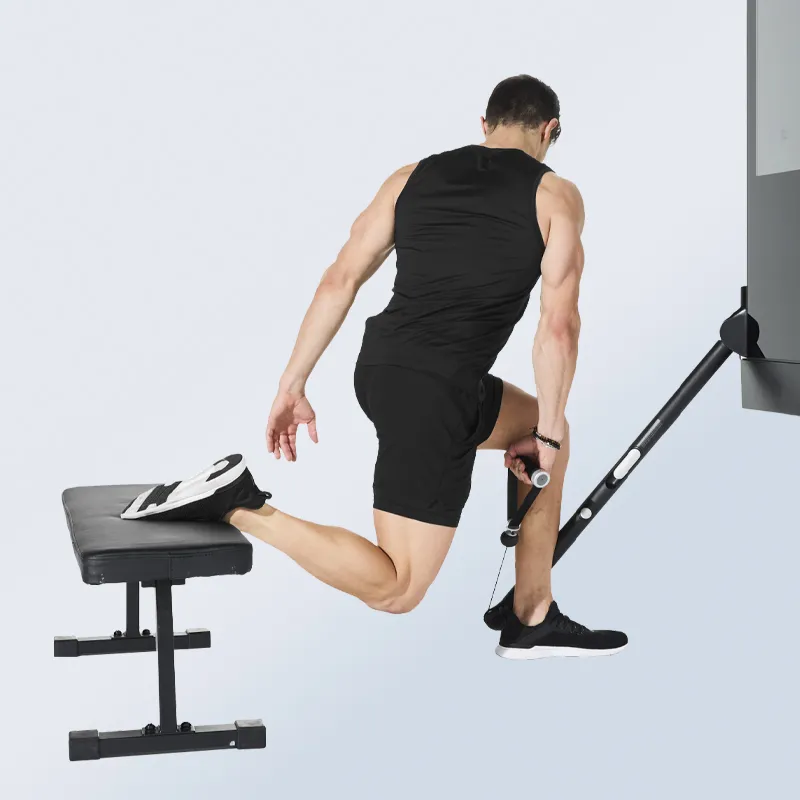
Why it Works: To add a little extra to an already challenging move, Wilking likes this Bulgarian split squat variation that incorporates internal hip rotation. By improving mobility in the hip through internal rotation, cyclists can unlock a greater range of motion which may prevent injuries. “This move is designed to challenge rotation at the bottom of the movement,” she says. By activating the hips, cyclists can better engage the core as they ride.
How to Do it: Line one foot up with the end of Tonal’s arms. Reach your opposite leg back, placing the top of your foot on the bench. Grab the handle closest to your front leg with the opposite arm and stand tall. Rotate your torso toward your front leg as you bend your knees to lower your hips until your front thigh is parallel to the floor. Press the floor away from you to come to standing and repeat.
Barbell Deadlift
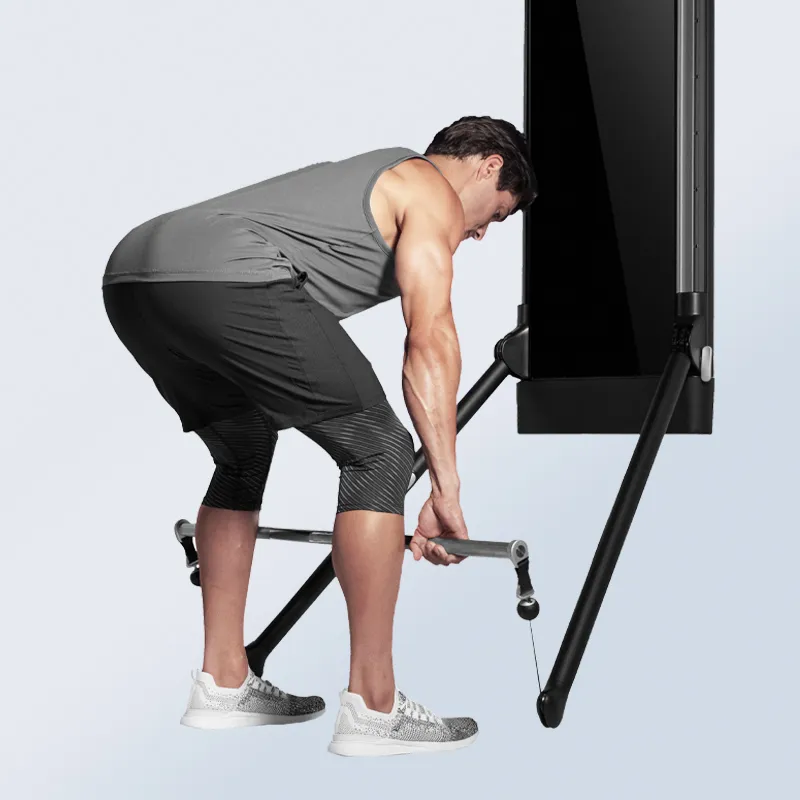
Why it Works: The deadlift is such a valuable exercise because of its ability to increase power and strength in the posterior chain: the back, glutes, and hamstrings, says Nicolette Amarillas, Tonal coach and postural specialist. “These muscles are vital for speed and endurance. And when it’s executed correctly, it’s also a great exercise to counteract postural imbalances that may develop from being on a bike or sitting at your desk.
How to Do it: Stand with feet hip-width apart, laces lined up with the end of the Tonal’s arms. Bend your knees slightly then send your hips back into a hinge position. Grab the bar with your hands outside your knees. Stand by pushing the floor away from you, pulling the bar up your thighs, and keeping your back as straight as a wall. Once at the top, keep your chest proud as you reach the hips back and return to the bottom position, then repeat.
Triceps Extension

Why it Works: Ever finish a ride and realize your triceps are more sore than your legs? That’s why a solid strength training for cyclists routine should include upper body moves, too. “This move is great for reducing fatigue on the triceps during long rides,” says Letchford. The isolated motion also helps stretch your triceps and lats, which can feel great post-ride.
How to Do it: Extend your elbows to bring your hands down toward your hips, working the back of the arms. Imagine a magnet between your shoulder blades as you pull the rope down. Control your hands back up until they are just above the elbows. Repeat.
Y-Pull
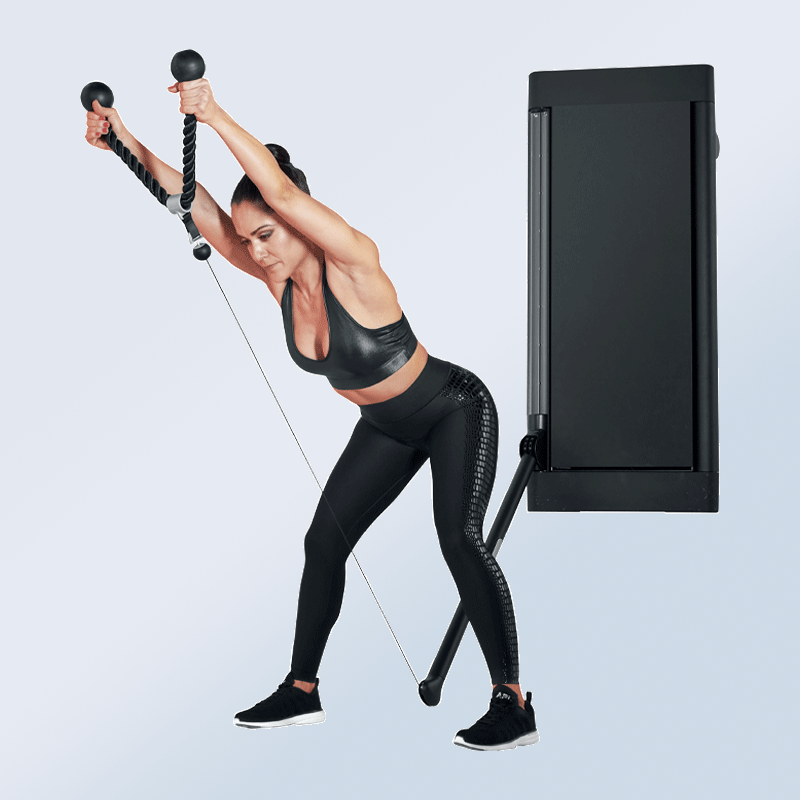
Why it Works: While you’re working on your upper body, don’t forget your shoulders. “Cyclists’ shoulders tend to lose a little bit of the strength training love,” says Wilking. “But having both stability and movement in the shoulder is key for avoiding injury while in a repetitive pattern.” She likes this move for building strength and range of motion in the shoulders. It’s a single-joint exercise that isolates the shoulder movement while challenging the muscles of the back and posterior chain.
How to Do it: With straight arms, lift the rope in front of you to bring your biceps to your ears, aiming your hands toward the wall behind you. Lower back down to the starting position with straight arms.
Resisted Step-Up
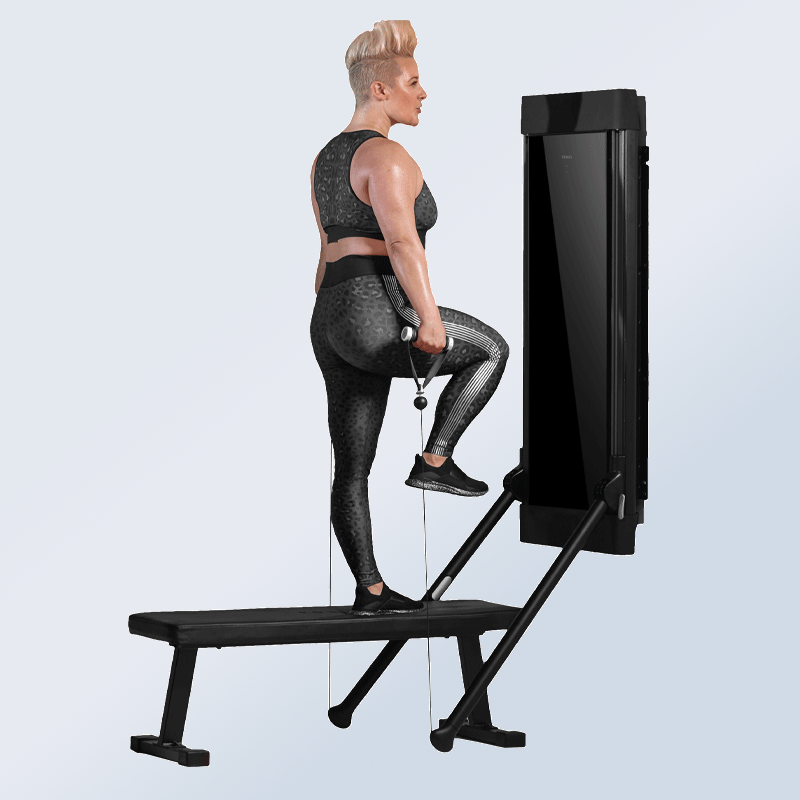
Why it Works: A step-up mimics the push your legs make with every pedal stroke, and adding weight makes it more of a strength and balance challenge. “It improves pedal power by strengthening the glutes and quads, the muscle groups responsible for big lower body pushes,” explains Letchford.
How to Do it: Take a handle in each hand. Place one foot on the center of your bench in line with the end of the Tonal’s arms. Press through the heel to push the bench away from you and stand tall, keeping the resting leg relaxed. Lower down with control using your glutes, lightly tapping the floor with the relaxed leg, and repeat on the same side.
Suitcase Deadlift
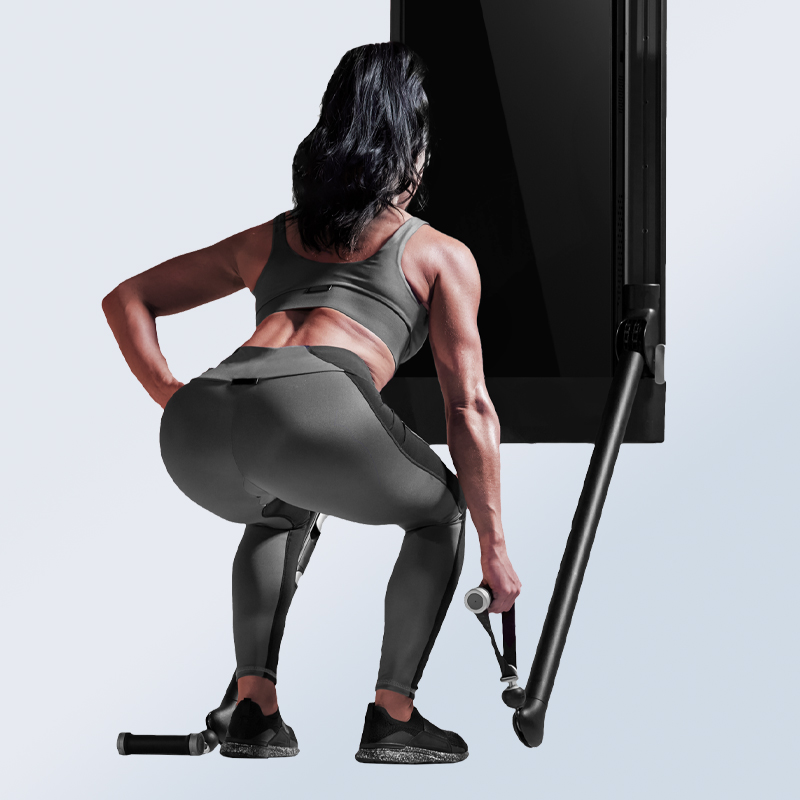
Why it Works: This unilateral move helps develop the strength of each leg separately — it just requires more knee flexion. “This gives you more glute and quad engagement, but less hamstring work,” says Amarillas. “I love the Suitcase Deadlift because it forces you to use the core in a different way, stabilizing the trunk through anti-rotation and avoiding lateral flexion of the spine.”
How to Do it: Start with feet hip-width apart. Send hips back and bend knees to grab one handle with your right hand. Resisting a side bend, press the floor away from you, pushing through your heels to stand tall, keeping your arms straight at your sides. Once at the top, keep your chest proud as you reach your hips back and return to the bottom position. Repeat on the same side.
Resisted Lateral Lunge
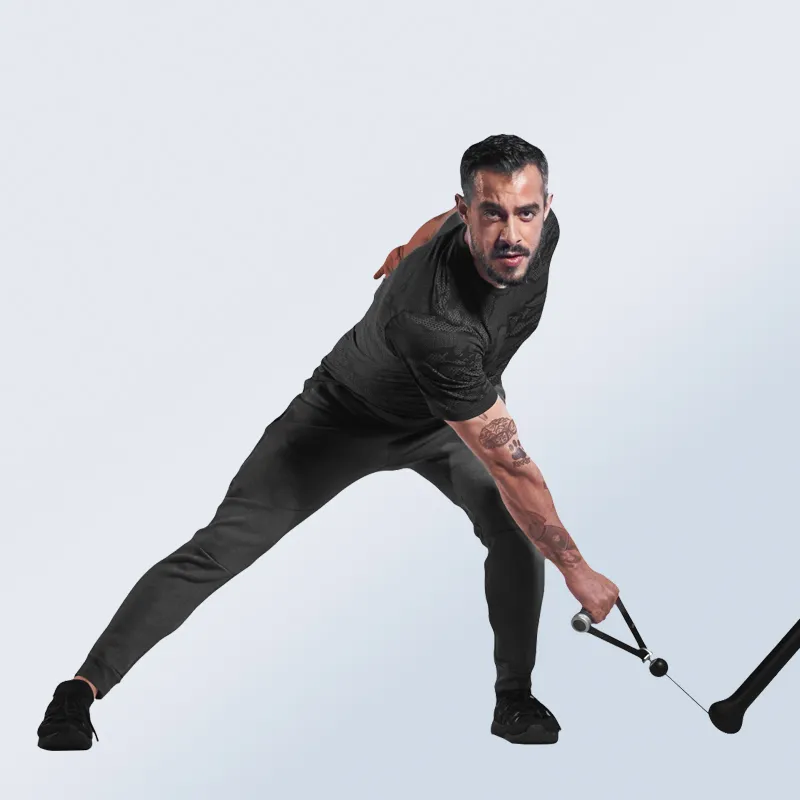
Why it Works: “I often work with cyclists who have knee or back pain stemming from a lack of activation in the hip stabilizers,” says Letchford. “This movement strengthens the outer hips while focusing on developing power and building a stronger, more stable core — which includes the hips — for a solid ride. When the core is strong, the legs have a strong foundation.”
How to Do it: Take the handle in one hand and take a few large steps away from Tonal. Stand sideways so the handle is on the far side of your body with the cable crossing in front of you. Take a wide step toward Tonal and sit back into your inside leg like you’re sitting into a chair while keeping the other leg straight. Press the floor away from you with the inside leg and return to standing. Repeat on the same side.
Reverse Lunge with Rotation
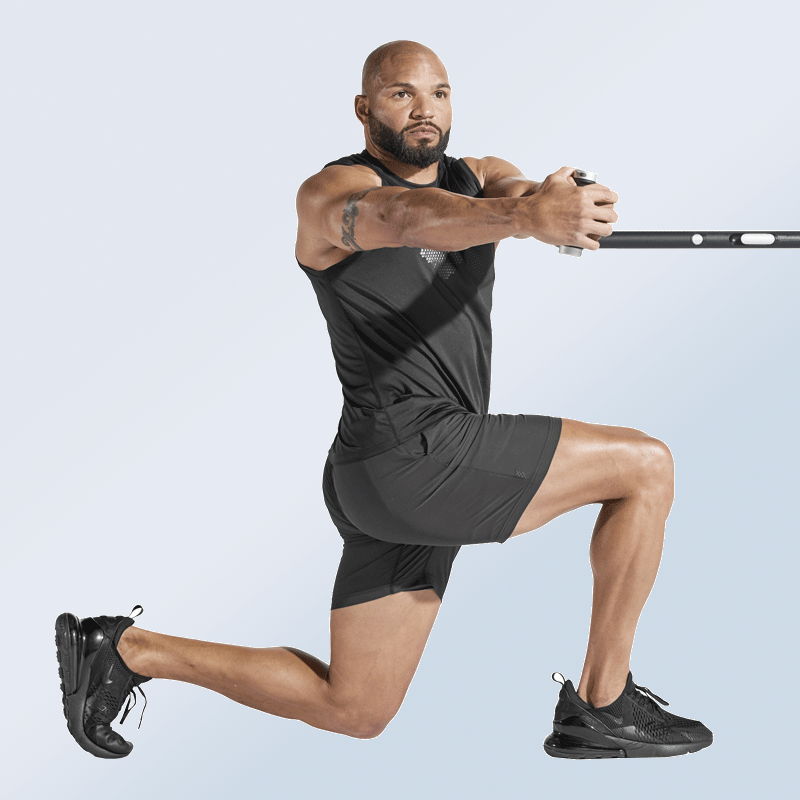
Why it Works: Combining the lower-body strength of a lunge with the core stabilization of a Paloff press, this move is one of Wilking’s favorites for all-around cycling strength and durability. “Trunk stability is vital while generating power with the lower body,” she says.
How to Do it: Stand perpendicular to Tonal with one side facing the end of Tonal’s arm. Take one handle in both hands and bring it to your torso just under your chest. As you reach the leg closest to Tonal’s arm behind you, press the handle forward in front of you. Once your back knee is just above the floor, rotate your torso away from Tonal with straight arms. Rotate back to center and then stand by pushing the floor away with your front leg. Bend the elbows to finish with the handle in front of your torso and repeat on the same side.
Resisted DNS Star
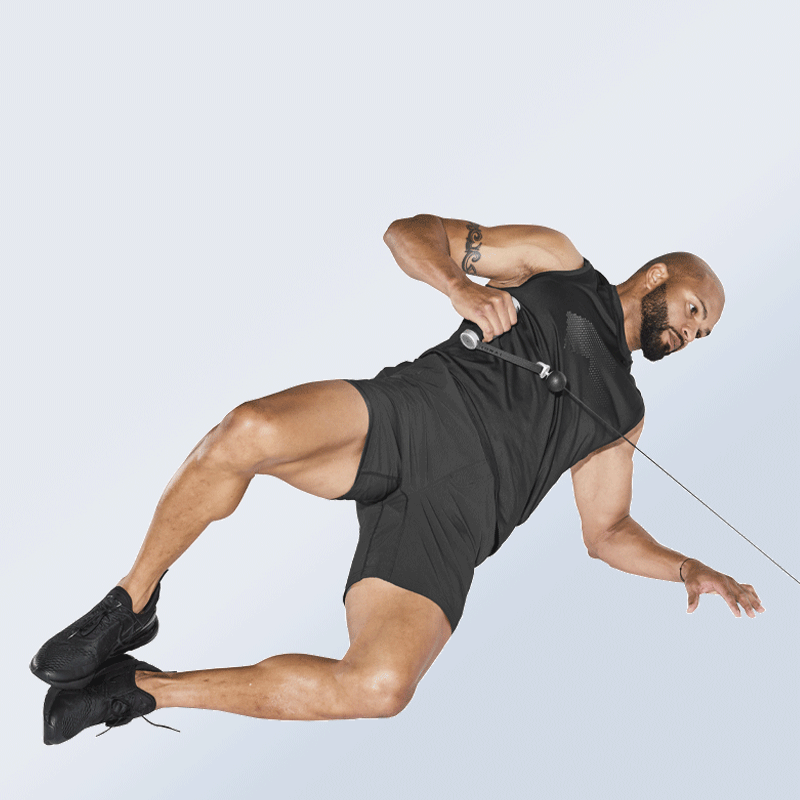
Why it Works: Since cycling requires full-body stability, Wilking likes how this move challenges the hips, pelvis, and shoulder complex. “This is a great accessory exercise to mix with your main lifts,” she says.
How to Do It: Facing Tonal, lay on your side with your elbows directly under your shoulder and your knees bent, stacked on top of one another. Grab the handle with your top arm. As you pull the handle toward your torso just under your chest, lift your hips away from the floor and forward toward Tonal, keeping your bottom knee on the floor and lifting the top knee to open the hip. Let the handle move forward as you lower the hips down and back away from Tonal to the starting position.
Bird Dog With Row
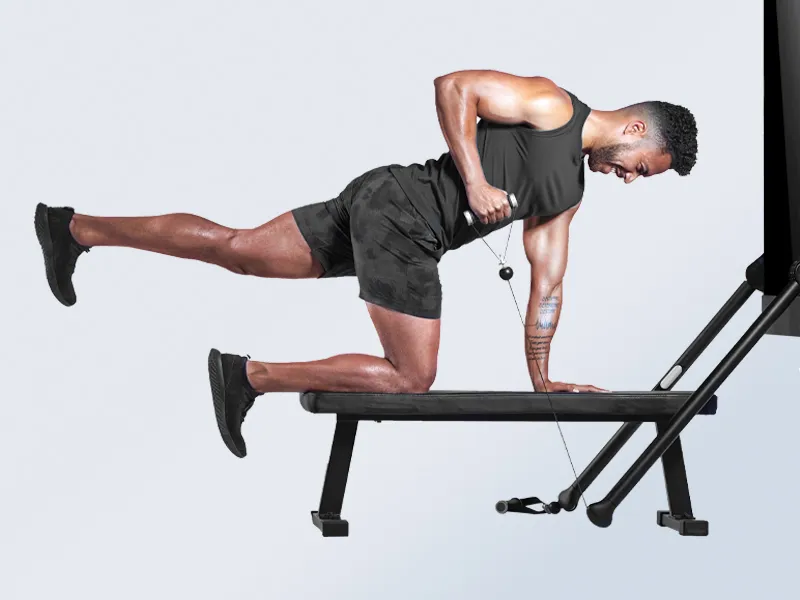
Why it Works: This move requires serious anti-rotational strength (which challenges your core), in addition to building shoulder and back strength, says Letchford. “The shoulders are responsible for providing stability while the hands are on the handlebars, so improving that strength can lead to more comfortable rides, less neck and upper back tension, and a decreased risk for overuse injury.”
How to Do it: Start on all fours on your bench with your wrists under your shoulders and your knees under your hips. Extend one leg toward the ceiling and grab the handle with your opposite hand, balancing on the two limbs. Using your back, pull the handle toward your ribcage pointing your elbow to the ceiling. Control the weight back down and repeat on the same side.
How to Create Your Strength Training for Cyclists Workout on Tonal
To make your own strength training for cyclists workout on Tonal, use the Custom Workout feature on the Tonal mobile app to create a workout with the moves listed above. With Custom Workouts, you can choose the exact number of sets and reps you want to complete, add any dynamic weight modes, and have all of your progress tracked. You’ll also have access to your Tonal weight recommendations so there’s no need to guess how much resistance to use for each exercise.
Karen Iorio Adelson contributed to this story.
